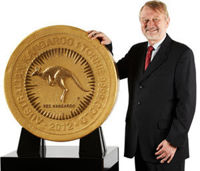Posted on July 15, 2021

By Paul Vanguard, for BullionMax.com
Anyone with any numismatics experience can tell you that a small coin can fetch a massive price. Antique coins whose diameter measures in millimeters can fetch prices of between $100,000 and $1 million. But we aren't here to talk about small coins with high price tags. We're here to talk about the big, the large and the massive coins with high price tags.
When it comes to issuing massive gold coins, there definitely seems to be a bit of competition between the world's top mints.
Specifications
The Royal Canadian Mint started the "bigger is better" fad with their 220-pound Big Maple Leaf coin in 2007. They were already the first to produce "five nines fine gold" and were probably pretty smug about their place at the top of the global mint food chain. That wasn't enough for them, though. They wanted to make the world's biggest coin.
Why? In their words:
Why did the Royal Canadian Mint make the world's purest and largest gold bullion coin? Because we can.
The Big Maple Leaf (yes, that's it's real name) has a CAD$1 million face value and was the first Guinness world record holder for the largest coin.
The Canadian mint went on to strike five more of these coins for private investors. Each held a gold value of $4 million.
If you're thinking, "That's an awful lot of eggs in one great big basket," you're not wrong. The owner of one of these privately-held Big Maple Leaf coins lent it to a museum for display. And it was promptly stolen. While suspects have been apprehended, the coin hasn't been recovered. Investigators believe it's been cut into pieces and sold for its melt value.
Clearly, too heavy for most people to lift isn't much of a security feature. Maybe that's why the Australians went even bigger?
Specifications
Since 1991, Perth Mint made gold nugget coins (more often known as kangaroo coins, or just kangaroos) in weights ranging from 1/10 oz all the way up to 1kg (32 oz). But that wasn't big enough.
So, in 2011, the Perth Mint decided to promote its Kangaroo gold coin and its fund by minting a 2,200 pound gold coin of 99.9% purity. But was that the real reason? The One Ton Australian Kangaroo gold coin swiftly, despite its weight, made it to the Guinness Book of World Records as the largest-ever gold coin a year later.
For a decade, Perth Mint has held onto that record. We doubt anyone will be challenging it soon.
But that hasn't stopped world mints from making their own ridiculously large coins...
Specifications
Perhaps intimidated by the Kangaroo's size, the U.K.'s Royal Mint seems to have abandoned hopes of matching the coin in size and weight and instead focused on detail. Its 10-kilo gold coin is the largest ever made in the Mint's 1,100 years of operation, and the website doesn't hesitate to share the details on its construction. It took a team of top craftsmen over 400 hours to create the coin, with 4 days spent on polishing alone. It is certainly the most elaborate coin on this list, featuring many carefully-designed animals from the Queen's Beasts coin series.
Specifications
It's good to see that the theft of one of Canada's large coins hasn't deterred the mint's gigantic pursuits, as it followed up in 2011 with The World's First 10-kg 99.999% Pure Gold Coin, which sports a mystical motif and a CAD$100,000 denomination (the second-highest the RCM ever issued). Only fifteen were minted.
Supermassive efforts like these might seem possible only due to modern advancements in minting. Especially if you read about the challenges the U.S. Mint faced when making the relatively-petite 5 oz. America the Beautiful series.
However, absurdly large coins aren't a solely modern phenomenon...
Specifications
This coin, about the size of a hockey puck, was actually intended for circulation when it was produced. Fortunately, sanity intervened before many of these were minted.
And now, the official BullionMax award for largest coin ever...
Specifications
The Yap tribes of Micronesia were pioneers in the development of impractical coinage. They have a centuries-old tradition of carving out stone coins of up to 8,800 lbs in weight and some 12 feet in diameter. These coins would often stay in one place even as ownership transferred, which is an interesting concept!
In a 1991 paper, economist Milton Friedman argued that while the Yap system of immobile money might seem bizarre at first glance, it was not so different from the operation of the gold vault of the Federal Reserve Bank of New York, which can pay gold from one government to another without the gold ever leaving the vault.
Paul Vanguard is a lifelong precious metals enthusiast and a proud member of the BullionMax team.